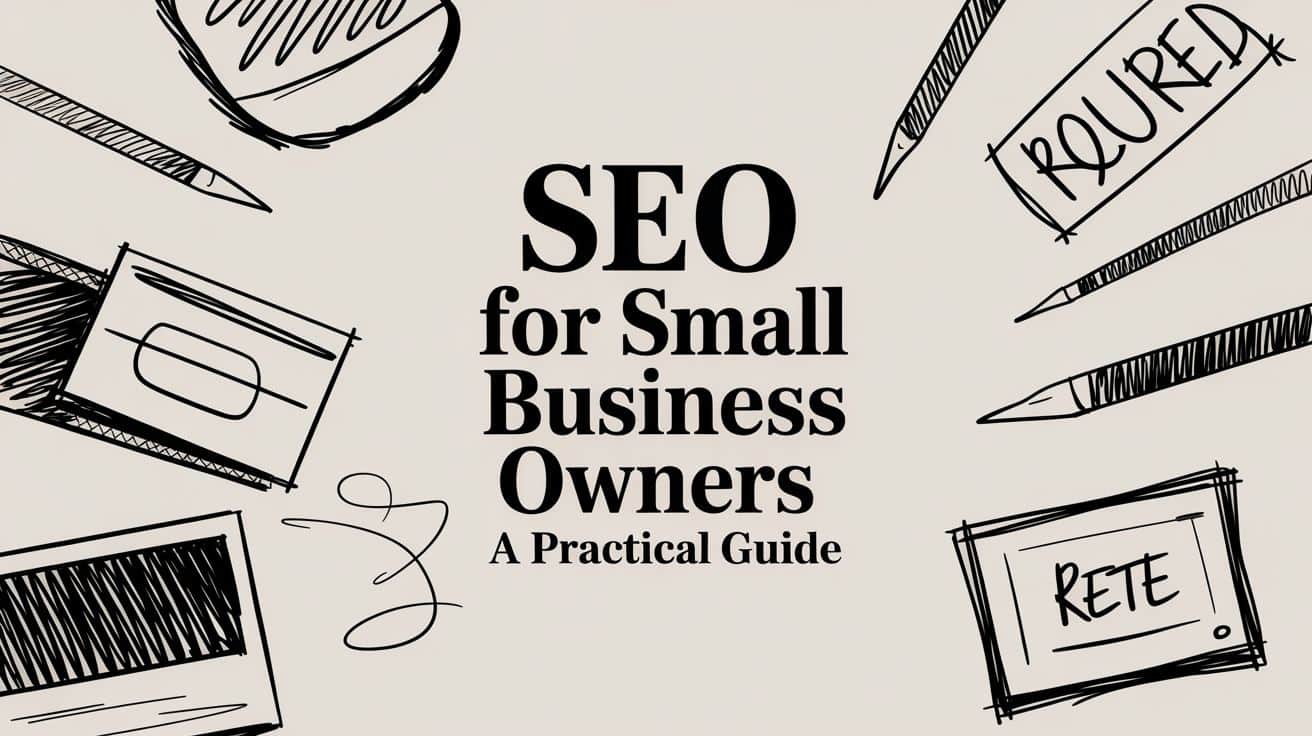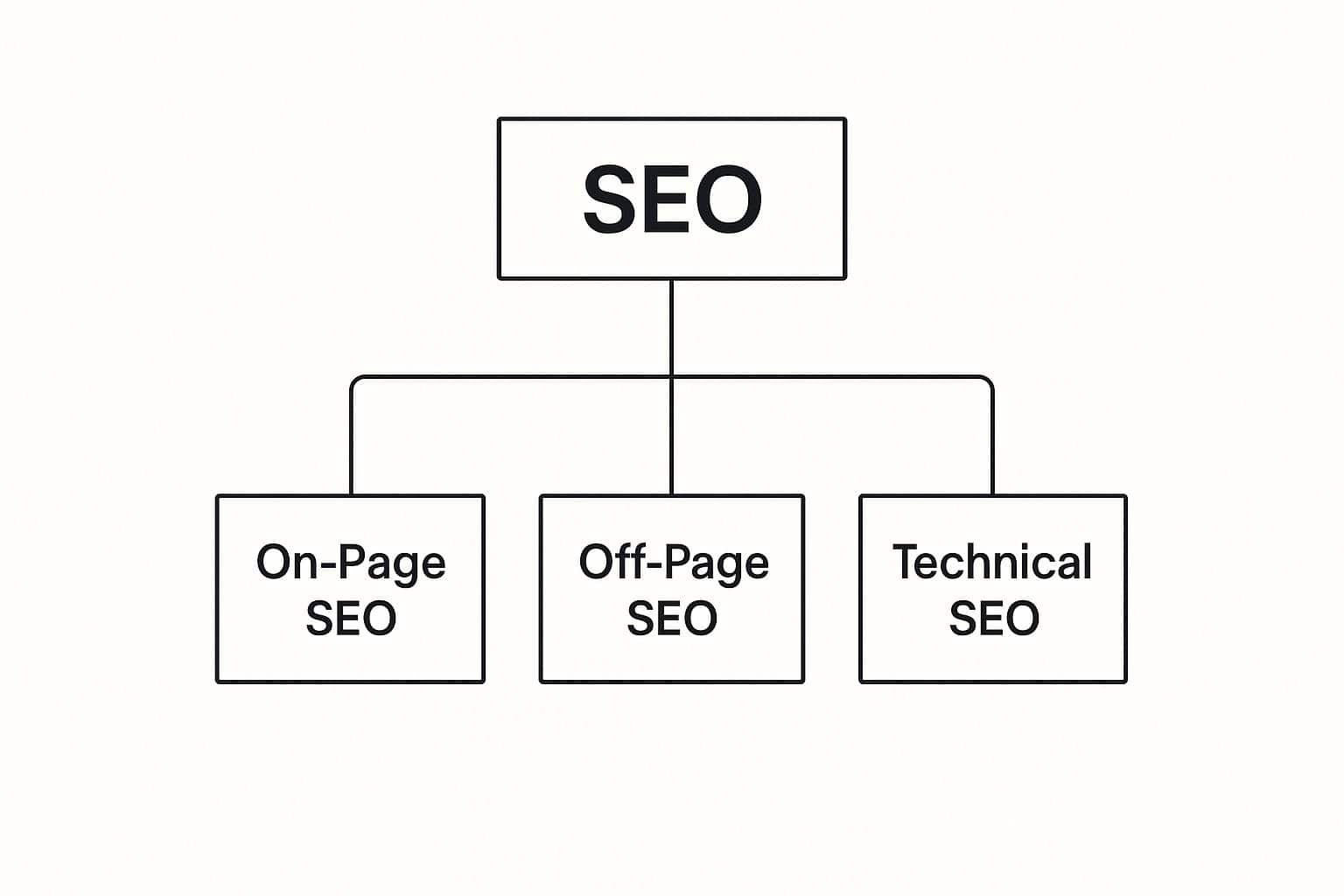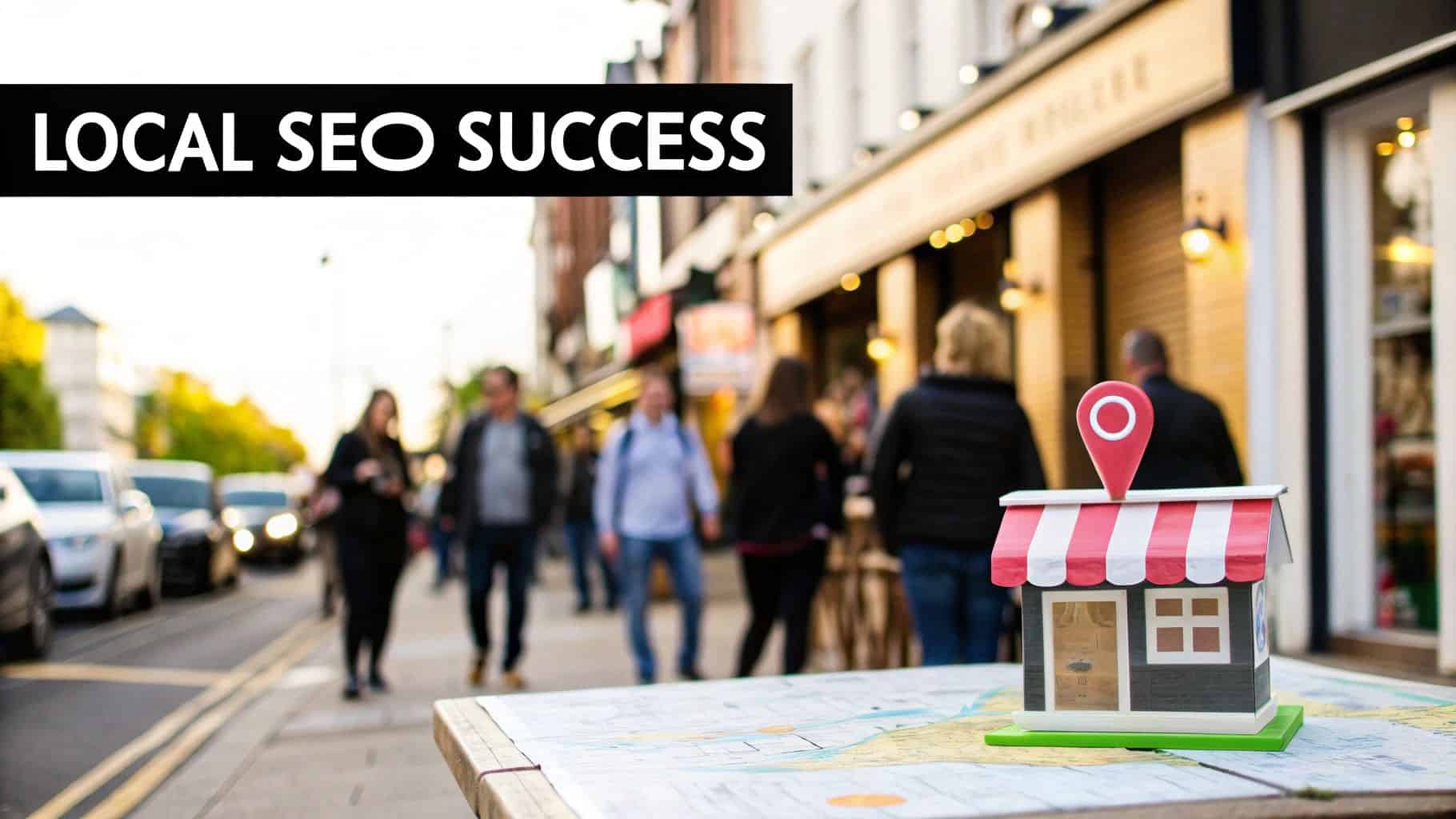SEO for Small Business Owners A Practical Guide

When we talk about SEO for small business owners, we’re really talking about making your website easy for the right people to find on search engines like Google. Think of it like the curb appeal for your digital storefront. It’s what draws your ideal customers in the exact moment they’re looking for what you sell.
In short, it’s your best 24/7 salesperson, and it’s an absolute game-changer for growth.
Why SEO Is Your Business Growth Engine

Let’s say your perfect customer is searching online right now for a problem you can solve. Will they find you, or your competitor? That’s not a question of luck—it’s a question of SEO.
Lots of business owners hear “SEO” and think it’s some mysterious, technical beast. But it’s much simpler than that. At its heart, SEO is about making your website the most helpful, relevant answer to your customer’s question. When you nail that, Google rewards you with visibility, which leads to trust, traffic, and sales.
Your Digital Salesperson That Never Sleeps
Paid ads are great, but they stop the second you stop paying. A solid SEO strategy, on the other hand, works tirelessly in the background. It keeps bringing in organic traffic—visitors who find you on their own—long after the initial work is done. You’re not paying for every single click.
This builds a reliable pipeline of new leads and customers that you actually own.
The return on this effort is impressive. It’s estimated that by 2025, small businesses that invest in SEO can see an average ROI of 400% within just two years. And since 53% of all website traffic comes from organic search, not optimizing your site is like leaving money on the table.
With a strong SEO foundation, you can:
- Build Trust and Credibility: When you rank high on Google, customers automatically see you as a trustworthy leader in your field.
- Get High-Quality Leads: The people finding you through search are actively looking for solutions. They’re not just browsing; they’re ready to buy.
- Outrank Local Competitors: Good SEO can help you completely own the local search results, putting you miles ahead of the competition down the street.
SEO is a long-term asset. The work you put in today—creating helpful content, optimizing your pages—keeps paying you back for months, even years. It’s like planting a tree that will bear fruit for a long time.
Making Growth Achievable
My goal here is to show you that SEO isn’t just for big companies with huge marketing departments. You don’t need a massive budget to succeed.
With the right strategy and a clear plan, you can take control of your online visibility and turn your website into a growth machine. You can also explore how SEO can make you money to see the real financial impact. It all comes down to making smart, consistent efforts that build on each other over time.
Understanding The Three Pillars of SEO
Search Engine Optimization can feel like a massive, tangled web of rules, but it really just comes down to three core areas working together. For a small business owner, getting a handle on these fundamentals is your ticket to building a real online presence.
Let’s think of your website like a new restaurant you’re trying to put on the map. To succeed, you absolutely need three things:
- A fantastic menu and a welcoming dining room.
- A great reputation around town that brings people in.
- A building that’s easy for customers (and search engines) to find and get into.
These three needs line up perfectly with the three pillars of SEO.
This simple breakdown shows how On-Page, Off-Page, and Technical SEO all lock together to form a complete strategy.

As you can see, you can’t just focus on one. They’re all connected, and a weakness in one pillar can bring the whole structure down.
On-Page SEO: What Happens On Your Website
On-Page SEO covers everything you can directly control on your website’s pages. This is your chance to tell both your visitors and search engines exactly what you’re all about. It’s the words on the page, the quality of your content, and the way you organize it all.
Back to our restaurant analogy, On-Page SEO is your menu, the decor, and the helpfulness of your staff. Do your menu descriptions (your page content) make the food sound incredible? Is the restaurant clean and easy to walk through (your site structure)? This pillar is all about creating a valuable and clear experience for anyone who “walks in.”
Key elements of On-Page SEO include:
- High-Quality Content: This means creating blog posts, service pages, and articles that genuinely solve a problem or answer a question for your audience.
- Keyword Optimization: Weaving the search terms your customers actually use into your page titles, headings, and text in a natural, non-robotic way.
- Internal Linking: Guiding users and search engines to other relevant pages on your site. It’s like a helpful waiter saying, “If you like that dish, you’ll love this one.”
Off-Page SEO: Building Your Reputation Online
Off-Page SEO is everything that happens away from your website to boost your rankings. This part is all about building your site’s authority and online reputation. In short, it’s what other people on the internet are saying about you.
For our restaurant, this is its word-of-mouth reputation. It’s the glowing review in the local paper, the food blogger who raves about your signature dish, and the shout-out from another popular local business. These outside signals build trust and tell search engines that you’re a legitimate, important place to visit.
The most critical piece of Off-Page SEO is backlinks. A backlink is simply a link from someone else’s website pointing to yours. Google sees high-quality backlinks as votes of confidence, signaling that your content is valuable and trustworthy.
Other Off-Page signals include:
- Brand Mentions: Your business getting talked about on other sites, even if they don’t include a direct link.
- Social Media Shares: People sharing your articles and pages on platforms like Facebook, LinkedIn, or X.
- Online Reviews: Positive feedback on your Google Business Profile, Yelp, or other industry-specific review sites.
Technical SEO: Your Website’s Foundation
Finally, Technical SEO is the foundation of the restaurant building itself. It has less to do with the content inside and more to do with your website’s backend structure. The whole point is to make sure search engines can crawl, index, and understand your site without hitting any roadblocks.
Think about it: if your restaurant is hard to find, has a door that won’t open, or the kitchen takes an hour to make an appetizer, people will leave and never come back. It’s the same online. If your site is slow, not secure, or a confusing maze for search engine “bots,” your rankings will tank—no matter how amazing your content is.
Common Technical SEO tasks involve:
- Site Speed: Making sure your pages load fast. A study found that 47% of consumers expect a webpage to load in two seconds or less.
- Mobile-Friendliness: Your site has to look and work flawlessly on smartphones. Google now primarily uses the mobile version of your site for ranking.
- Crawlability: You need to give search engines a clear roadmap to all your important pages. This is often done with a file called an XML sitemap.
By focusing on all three pillars—great content on your site, a strong reputation across the web, and a solid technical foundation—you create a complete SEO for small business owners strategy that actually gets you lasting results.
Your Launchpad For Local SEO Success

If you run a brick-and-mortar shop or a service-area business, your entire world is local. The person who needs you isn’t across the country; they’re probably just a few miles away, searching on their phone right now. This is why mastering local SEO isn’t just another marketing task—it’s the heart of your growth strategy.
Think of it like putting up a giant, flashing neon sign in the digital world. When someone nearby searches for “best coffee near me” or “emergency plumber in Austin,” you need to be the first name they see. This is how you turn those online searches into actual foot traffic and paying customers.
Master Your Google Business Profile
Your absolute best tool for getting noticed locally is your Google Business Profile (GBP). This is the free listing that pops up in Google Maps and the “Local Pack” in search results. It’s your digital storefront and, for many people, the very first impression they’ll have of your business.
Leaving your profile incomplete is like having a shop with a blank sign out front. You just wouldn’t do it.
Claiming and optimizing your GBP is non-negotiable. It’s a huge trust signal. In fact, research shows that businesses with a complete GBP listing are seen as 2.7 times more reputable by consumers.
You can create or manage your listing for free on the official Google Business Profile page. This is your command center for how you show up on Google Search and Maps.
To really make your profile work for you, focus on these key areas:
- Fill Out Everything: Don’t skip any sections. Add your services, hours, business description, and any special attributes like “woman-owned” or “outdoor seating.” The more info, the better.
- Show, Don’t Just Tell: Upload plenty of high-quality photos of your products, your team, and your location. Businesses with photos get 42% more requests for driving directions.
- Get Social with Reviews: Actively ask happy customers to leave a review. Even more importantly, respond to every single one—good or bad. It shows you’re listening and that you care.
The Power of Consistent Citations
With your GBP looking sharp, the next piece of the puzzle is building local citations. A citation is just an online mention of your business’s Name, Address, and Phone number (what we call NAP). These appear in online directories like Yelp, Angi, and other industry-specific sites.
The golden rule here is NAP consistency. Your business information must be absolutely identical everywhere it appears online. A tiny difference, like using “St.” on one site and “Street” on another, can confuse search engines and ding your local ranking.
Think of your NAP as your business’s digital fingerprint. If the prints are different across the web, Google gets confused about which one is the real you. Perfect consistency builds trust and reinforces your location authority.
This process gives search engines a crystal-clear understanding of who you are and where you operate, making them much more confident about showing your business to local searchers.
Essential Local SEO Checklist
To help you stay on track, here’s a straightforward checklist covering the must-do actions for boosting your local visibility.
| Action Item | Why It Matters | Quick Tip |
|---|---|---|
| Claim & Verify GBP | This is your digital storefront. Without it, you’re invisible on Google Maps and in local results. | Go to google.com/business and search for your business name to start the process. |
| Complete All GBP Sections | A full profile is 2.7x more likely to be considered reputable. It answers customer questions upfront. | Don’t forget attributes! Add details like “Wi-Fi” or “Wheelchair accessible” to stand out. |
| Gather Customer Reviews | Reviews are a huge ranking factor and build social proof. 88% of consumers trust online reviews. | Send a direct link to your GBP review page to happy customers via email or text. |
| Build Consistent Citations | Consistent NAP across directories confirms your location and legitimacy to search engines. | Use a tool like Moz Local or BrightLocal to audit and clean up your existing citations. |
| Optimize for Local Keywords | This tells Google exactly which geographic areas you serve. | Create service pages for specific neighborhoods (e.g., “Plumbing in Capitol Hill”). |
| Add Local Business Schema | This structured data helps search engines understand your NAP, hours, and other key info. | Use a schema markup generator and add the code to your website’s header or footer. |
Following this checklist methodically is the surest way to build a strong local SEO foundation that gets results.
Targeting Local Keywords On Your Website
Finally, your own website needs to scream “local.” You do this by weaving local keywords into your content in a natural way. Instead of a broad term like “landscaping services,” you need to get specific with location-based phrases.
For instance, a plumber in Denver should be creating content around terms like:
- “Denver emergency plumber”
- “drain cleaning in Capitol Hill”
- “hot water heater repair near Denver”
These phrases should appear in your page titles, headings, service descriptions, and blog posts. An incredibly effective strategy is to create dedicated pages for each major city or neighborhood you serve. This leaves no doubt in Google’s mind about which geographic areas you are the best answer for.
Putting all these pieces together—a stellar GBP, consistent citations, and a locally-focused website—creates a powerful engine for attracting nearby customers. For an even more in-depth look, our small business guide to local SEO breaks down even more advanced strategies. By following this blueprint, you can put your business squarely on the map and start winning in your own backyard.
Creating Content That Attracts And Converts

If your website is the storefront, then your content is everything you put on the shelves. It’s what actually powers your entire SEO plan. But just churning out articles isn’t going to move the needle. You have to create the right kind of content—stuff that directly answers your customers’ biggest questions and gently guides them to the solution you offer.
Think about it from your customer’s perspective. They’re typing a problem into Google, looking for an answer. Your goal is to have a page on your site that pops up and says, “I’ve got you covered.” This simple shift in thinking—from “What can I sell?” to “What do my customers need to know?”—is how you build real trust and attract the kind of visitors who are ready to become customers.
That’s really the heart of SEO for small business owners: becoming the most helpful, go-to resource in your field.
Finding What Your Customers Are Asking
Before you write a single word, you have to figure out what people are actually searching for. You don’t need a massive budget for this; you just need to listen.
Start with the questions you already get every single day. What do clients ask on the phone? What are their biggest headaches or misconceptions about your industry? Every one of those questions is a fantastic idea for a piece of content.
You can also use free tools right inside Google. Try searching for one of your main services and scroll down to the “People Also Ask” section. These are real questions from real people, giving you a direct line into their thought process. For a local roofer, this might unearth gold like, “how long does a roof replacement take?” or “what are the signs you need a new roof?”
Your best content ideas won’t come from a boardroom; they’ll come straight from your customers. Pay attention to their language, their worries, and their goals. When you create content that speaks directly to those needs, you’ll never run out of topics that attract the right people.
Matching Content To Customer Intent
Not every visitor to your site is at the same stage of their journey. Someone just starting their research has completely different needs than someone who has their credit card out, ready to buy. Your website needs to speak to all of them, using different types of content for different moments.
It’s just like a normal conversation. You wouldn’t launch into a hard sales pitch the second someone walks into your shop. You’d answer their questions first and build a little rapport. Your content should do the exact same thing, guiding people from basic awareness to taking action.
Let’s break down the three essential types of content every small business needs.
Authoritative Blog Posts That Answer Questions
These are your educational, top-of-funnel pieces. They’re built to answer all the “how-to,” “what-is,” and “why” questions your potential customers are asking. The goal here isn’t an immediate sale; it’s to prove your expertise and build trust. A great blog post can attract new visitors for years, working like a 24/7 lead-generation machine.
Here’s what this looks like in the real world:
- A Landscaper: “How to Prepare Your Lawn for Winter in 5 Easy Steps”
- A Financial Advisor: “What Is a Roth IRA and Why Should You Start One?”
- An HVAC Company: “7 Signs Your Air Conditioner Needs a Tune-Up”
These articles solve an immediate problem and position your business as a helpful guide. It’s the perfect first handshake.
Persuasive Service Pages That Drive Sales
Once someone understands their problem, their next search is for a solution. This is where your service pages take center stage. These pages are built to convert lookers into buyers by clearly explaining what you do, why you’re the best choice, and how they can get started.
Don’t just list features; focus on the benefits. Your service pages must answer the visitor’s ultimate question: “Is this the right solution for me?”
An effective service page needs three things:
- A Clear Value Proposition: Right at the top, state exactly what problem you solve.
- Social Proof: Use real testimonials, customer reviews, or case studies to build confidence.
- A Strong Call-to-Action (CTA): Make it obvious what to do next, whether it’s “Request a Free Quote” or “Schedule a Consultation.”
Targeted Local Pages For Foot Traffic
If you have a physical location or a set service area, local landing pages are an absolute must. These pages are designed to capture customers searching for services “near me” or in a specific city. Each page should be uniquely written for that location.
For example, a plumber might create separate pages for “Emergency Plumber in Springfield” and “Drain Cleaning in Shelbyville.” This tells Google you’re the local expert for that specific service in that specific town, which dramatically boosts your chances of showing up in the coveted local map pack. This is where local search intent meets powerful content.
Essential SEO Tools You Can Use For Free
Great SEO doesn’t have to break the bank. In fact, some of the most effective tools for tracking your progress and spotting new opportunities are completely free. Getting a handle on these essentials is a huge first step toward making smart, data-driven decisions for your business.
Think of these tools like the dashboard in your car. You wouldn’t drive across the country without a speedometer or a fuel gauge, right? In the same way, you can’t steer your SEO strategy without clear data on your performance, traffic, and how people are engaging with your site.
Let’s dig into the must-have tools every small business owner should have in their back pocket.
Google Search Console: Your Direct Line to Google
If you only use one SEO tool, make it Google Search Console (GSC). This free platform is basically your direct communication channel with Google. It tells you exactly how the search engine views your website, which keywords people are using to find you, and flags any technical hiccups that might be holding you back.
GSC is less about who is visiting your site and more about how they’re finding you to begin with. The insights you get from it are pure gold and simply aren’t available anywhere else. Setting it up is as simple as verifying you own your site, and then you’ve got access to a treasure trove of actionable data.
Here’s a peek at what the main performance dashboard looks like in Google Search Console.
This dashboard gives you a quick, at-a-glance overview of your clicks and impressions, making it easy to see how visible your site is on Google.
Google Analytics: Understanding Your Visitors
While GSC shows you how people find your site, Google Analytics (GA4) tells you what they do once they get there. This incredibly powerful free tool dives deep into your website traffic, showing you who your visitors are, where they came from, and which pages they’re spending the most time on.
For instance, you can see how many people are coming from organic search compared to social media. You can also figure out which of your blog posts are a hit, which helps you decide what kind of content to create next. It’s all about understanding user behavior.
The real magic happens when you use Search Console and Analytics together. GSC tells you the keyword that brought someone to your site, and GA4 shows you if that person stuck around and eventually became a customer. That connection is everything when it comes to measuring your return on investment.
Google Business Profile Insights: For Local Traffic
For any business that serves a local community, your Google Business Profile is your storefront on the internet. The built-in Insights are your report card. You can access this dashboard right from your profile, and it shows you how customers are finding your business on Google Search and Maps.
Here are a few key things you can track:
- How customers search for you: Did they type in your business name directly, or did they find you by searching for a category like “plumber near me”?
- Queries used to find you: See the actual search terms that made your profile pop up.
- Customer actions: Keep an eye on how many people called your business, asked for directions, or clicked over to your website straight from your profile.
These insights are absolutely vital for understanding your local market and tweaking your profile to get more calls and foot traffic.
While these three Google tools are the foundation, you can learn more about other free and paid options in this comprehensive guide to SEO tools to use in your campaign. By mastering these free resources first, you can measure and improve your online presence without spending a dime.
Taking Your SEO Beyond the Neighborhood
Once you’ve nailed down your local SEO and your business is thriving in your own backyard, you might start thinking bigger. For e-commerce stores, digital service providers, or any business that isn’t limited by geography, this is the natural next step. It’s about evolving from the best choice in town to a recognized name across the country.
This shift means looking past the “near me” searches. You’ll need a broader content and keyword strategy that speaks to a much wider audience, using your local success as a springboard for national recognition.
Targeting a National Audience
The biggest change you’ll make is in your keywords. You’ll move from specific, location-based phrases like “bakery in Boston” to much broader (and more competitive) terms like “gourmet cookie delivery” or “custom birthday cakes online.” These keywords have significantly higher search volumes and can attract customers from coast to coast.
So, how do you capture that traffic? By creating content that solves problems and piques the interest of a national audience. Think bigger than just your local services.
- In-depth Guides: Create comprehensive articles that establish you as an expert, like “The Ultimate Guide to Choosing Sourdough Bread.”
- Product Comparisons: Help customers make better buying decisions with content like, “Buttercream vs. Fondant: Which Is Right for Your Cake?”
- How-To Tutorials: Share your expertise with step-by-step instructions that also happen to feature your products.
This kind of content builds your authority on a much larger scale. It pulls in people who are searching for expert information, not just a business in their immediate vicinity.
Think of it like this: moving from local to national SEO is like taking your popular neighborhood food truck and launching a nationwide meal delivery service. Your recipes (products) are still the star, but your marketing and logistics (content and keywords) now have to appeal to and serve a much broader customer base.
Going Global with International SEO and Localization
If your ambitions stretch across borders, your strategy needs to evolve yet again. And let me be clear: simply translating your website into another language won’t cut it. You need localization.
Localization is about adapting everything—your content, your marketing messages, even your products—to fit the specific cultural nuances and language of each new market. It’s about truly understanding and respecting your new audience.
This isn’t just a nice-to-have; it’s a critical step for connecting with international customers. The numbers don’t lie. A staggering 75% of users prefer to buy products in their native language. According to research on global SEO localization efforts from Search Atlas, websites that properly localize can see as much as a 70% increase in organic traffic in just one year.
It’s proof that speaking your customer’s language—literally—is one of the most powerful ways to build trust and grow your business on a global scale. This is how you make your SEO for small business owners plan truly scalable for whatever comes next.
Common SEO Questions From Business Owners
If you’re just getting into SEO, you probably have a lot of questions. That’s completely normal. Instead of letting those unknowns hold you back, let’s clear them up right now.
Here are the answers to the questions we hear most often from small business owners.
How Long Does It Take To See SEO Results?
This is usually the first thing everyone asks, and the most honest answer is: it depends. SEO is a long-term play, not a quick fix. Think of it like planting a garden—it takes time for the seeds you plant to grow.
While you might see some quick wins from local SEO tweaks, like sprucing up your Google Business Profile, in just a few weeks, bigger goals take more patience.
For most businesses, seeing significant movement—like landing on the first page of Google for competitive keywords—can take anywhere from 4 to 12 months. A lot of things factor in, like how competitive your industry is, the current state of your website, and how consistently you work on it. The real key is to focus on making steady, consistent progress.
Can I Do SEO Myself Or Should I Hire Someone?
You can absolutely do this yourself. In fact, for many small businesses, a DIY approach is the best way to start.
You don’t need a massive budget to get results. By focusing on the core strategies in this guide—like mastering your Google Business Profile and creating truly helpful content for your customers—you can build a rock-solid foundation for growth on your own.
As your business grows, you might eventually decide to bring in an expert to handle the more complex stuff. But when you’re starting out, handling SEO yourself is not only doable but also incredibly powerful for understanding your own marketing.
What Is The Most Important SEO Task?
If you’re a local business, this one’s a no-brainer: claim and completely fill out your Google Business Profile (GBP). This is your digital billboard on Google and Google Maps, and for many local customers, it’s the very first impression they’ll have of your business.
A well-managed profile can directly lead to more phone calls, website visits, and foot traffic—often more than any other single SEO effort.
To get the most out of it, make sure you:
- Fill out every single section. Don’t leave anything blank.
- Actively get more reviews. Ask happy customers for feedback and always respond.
- Keep your photos fresh. Add new pictures of your work, your team, and your location.
- Use Google Posts. Think of them as mini-ads or updates you can share directly on your profile.
For local businesses, a great GBP is the fastest way to get real, measurable results.
Ready to put these ideas to work? At Tech Geekers, we create simple, actionable guides to help small business owners succeed online. To learn more and take control of your growth, visit us at https://techgeekers.com.



